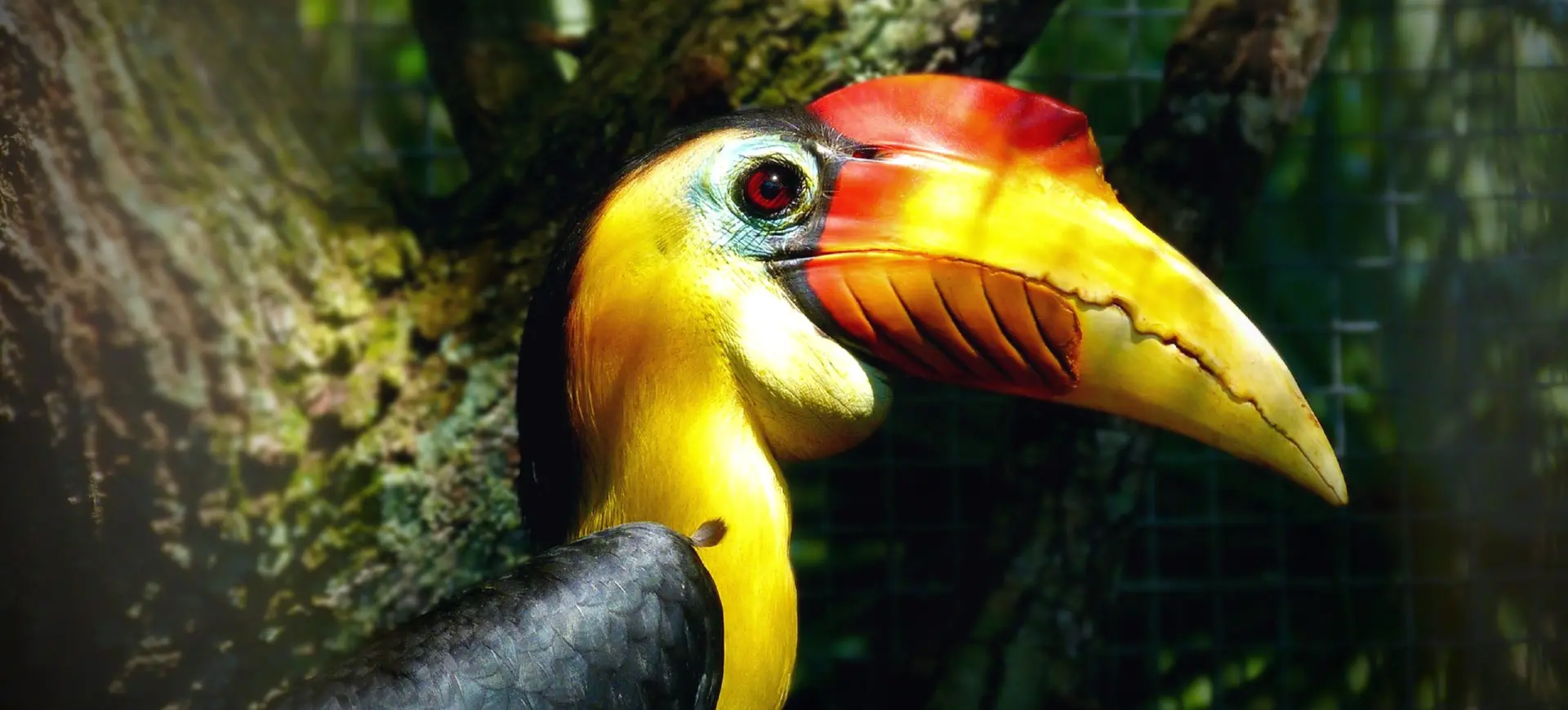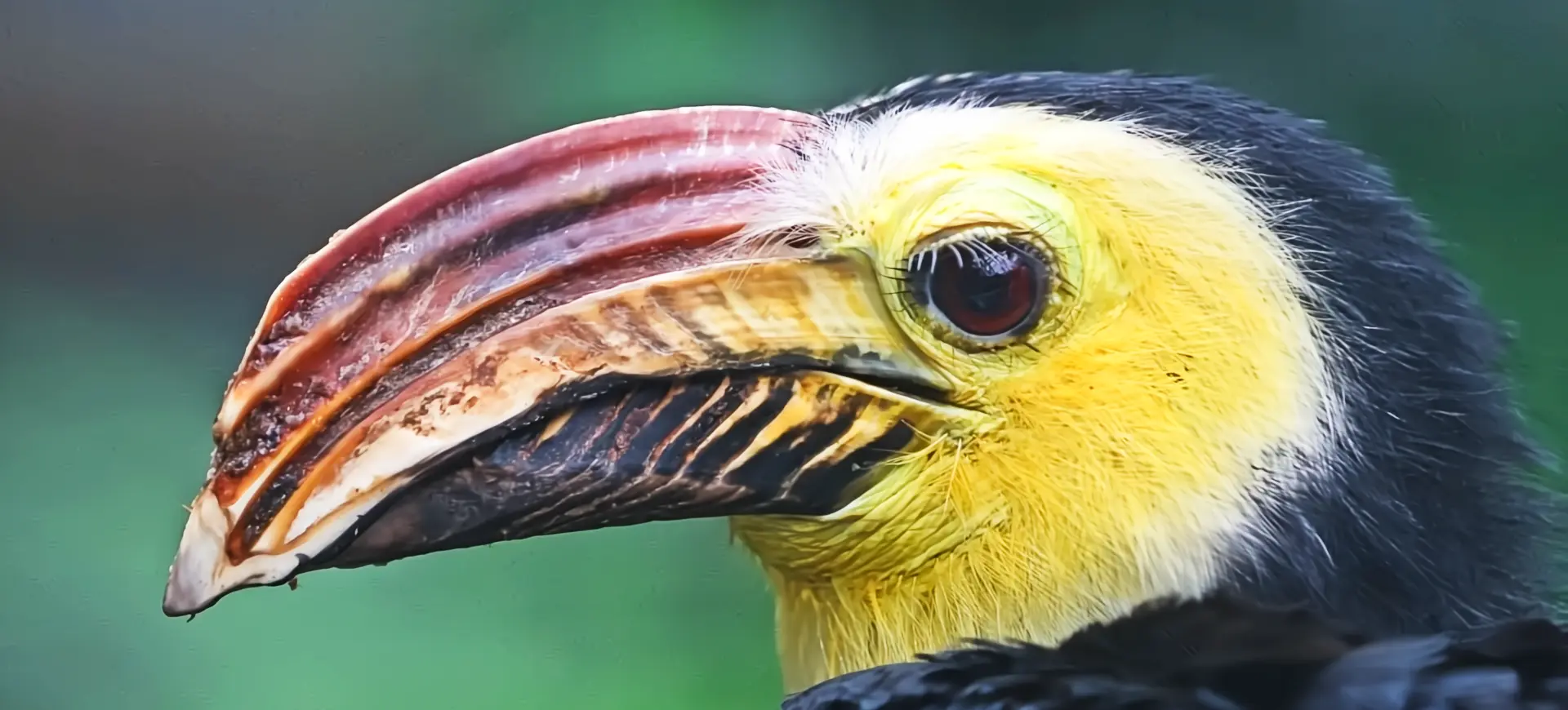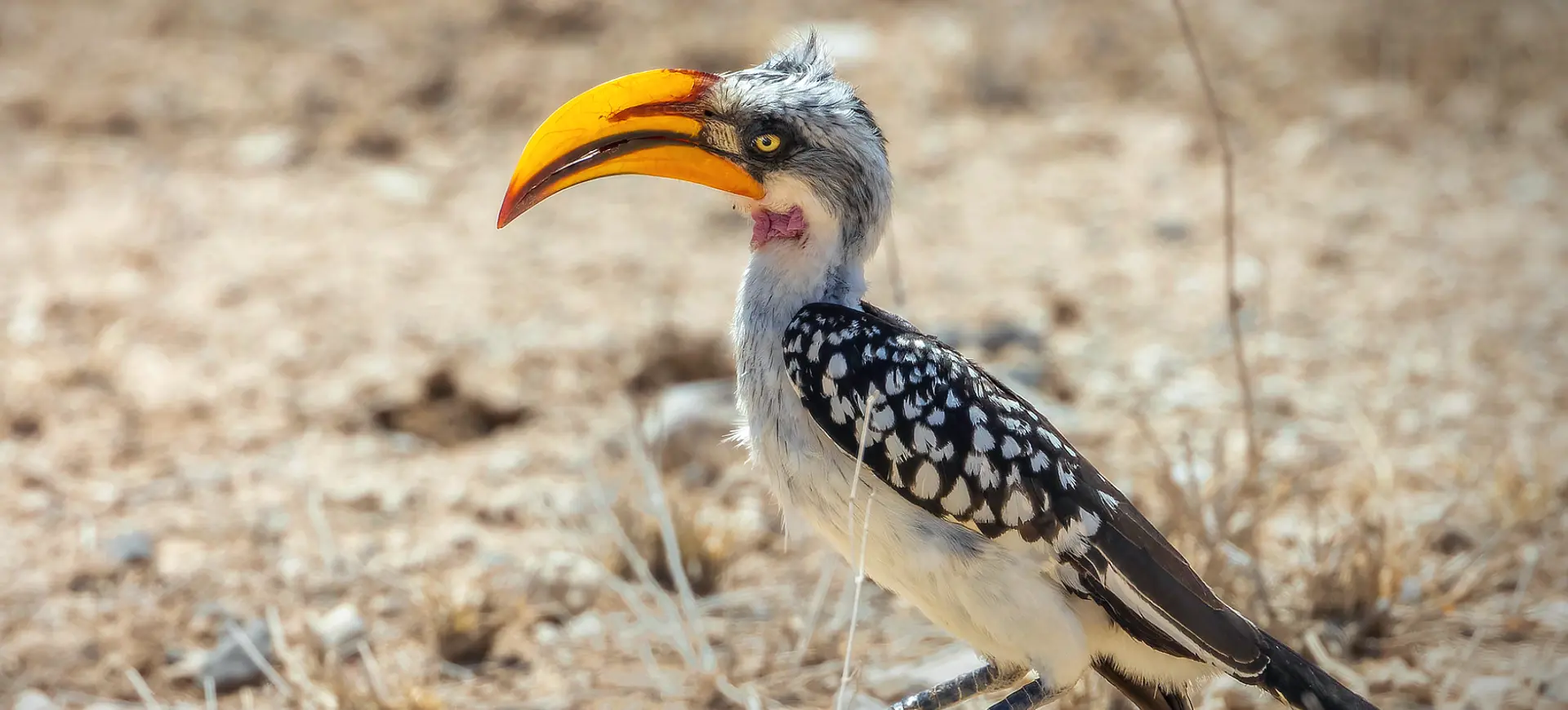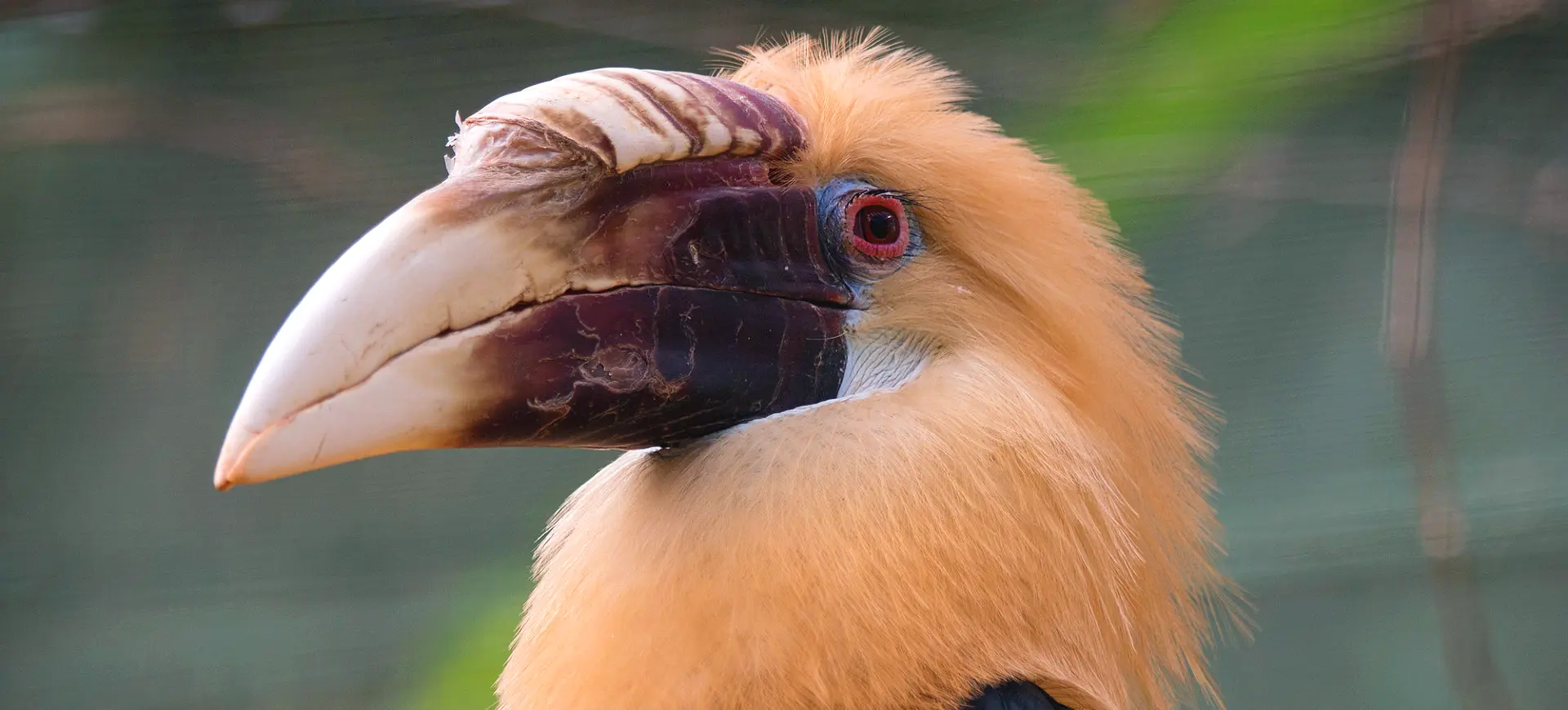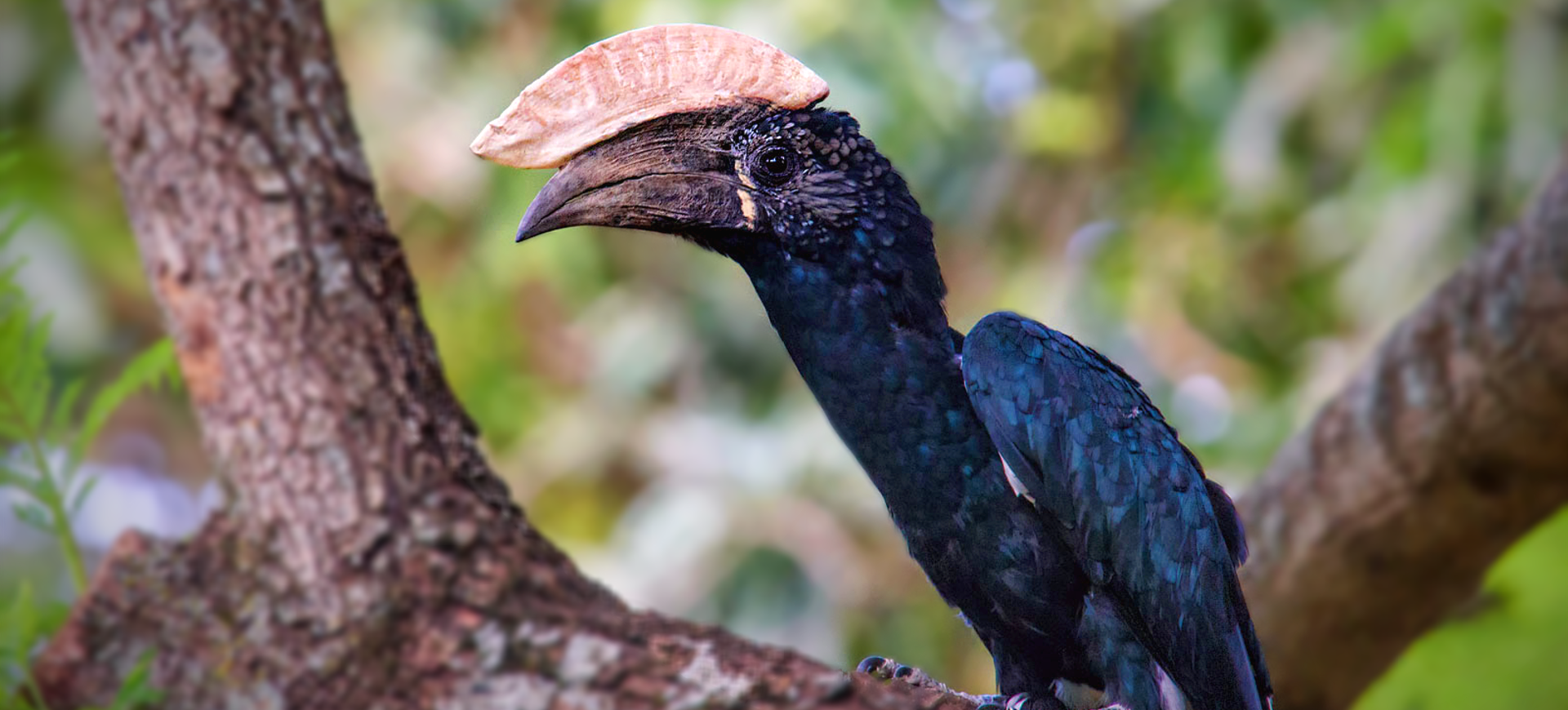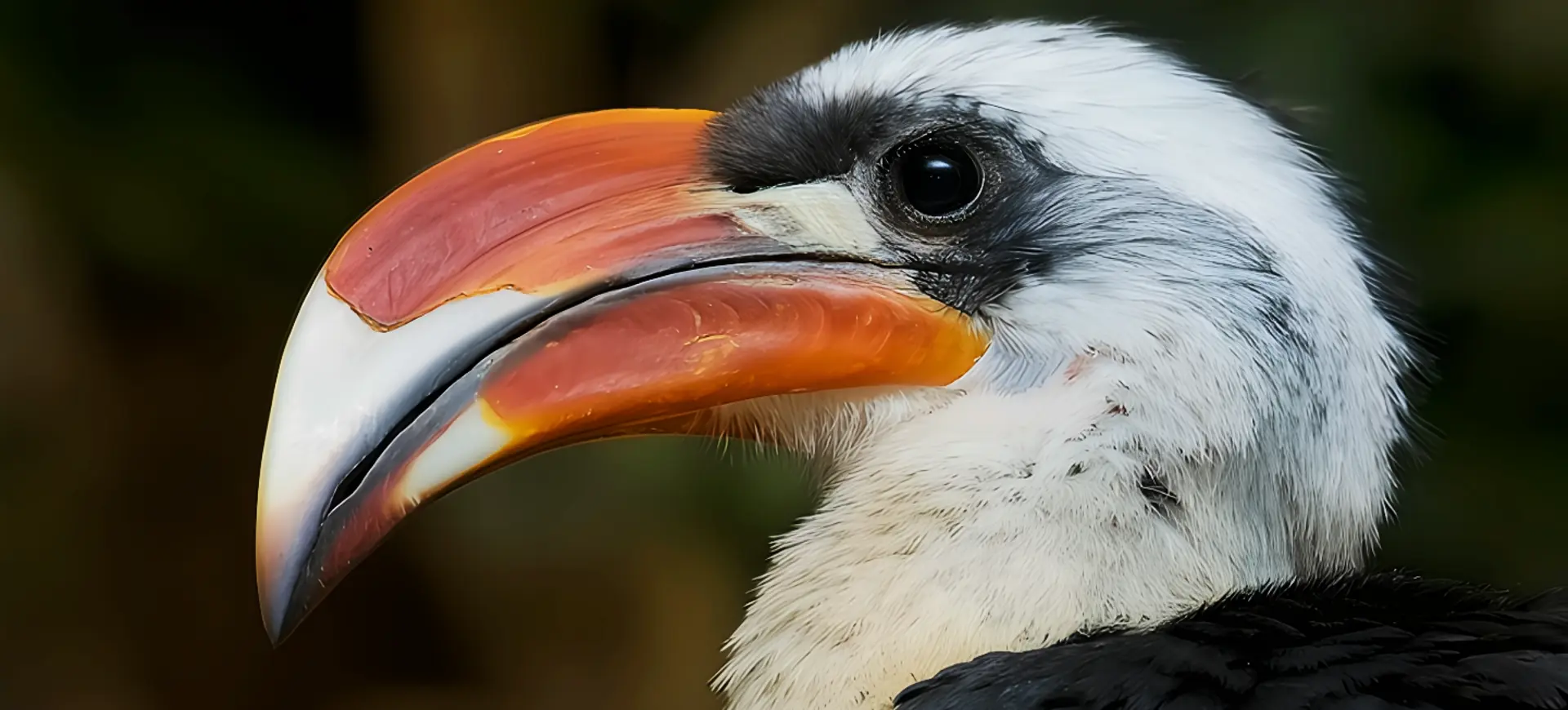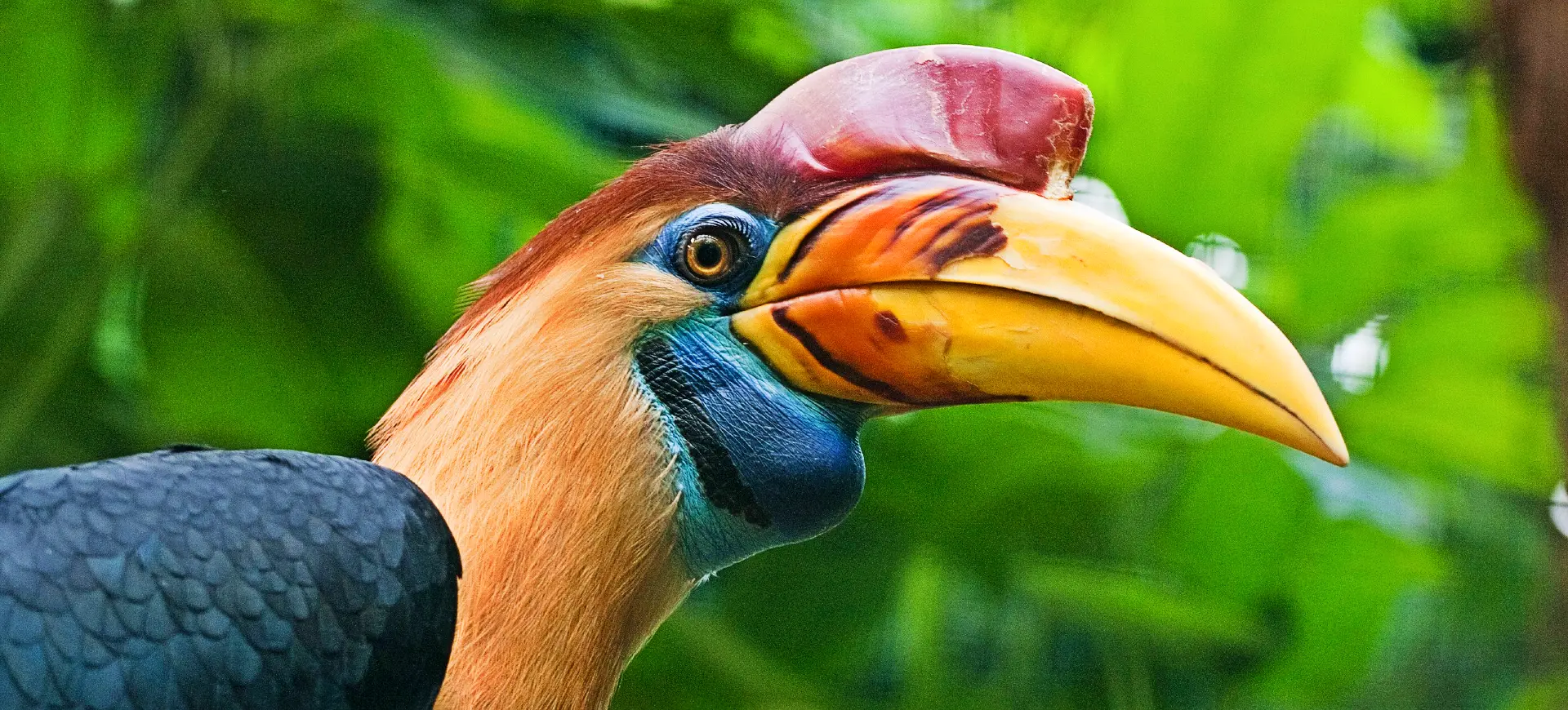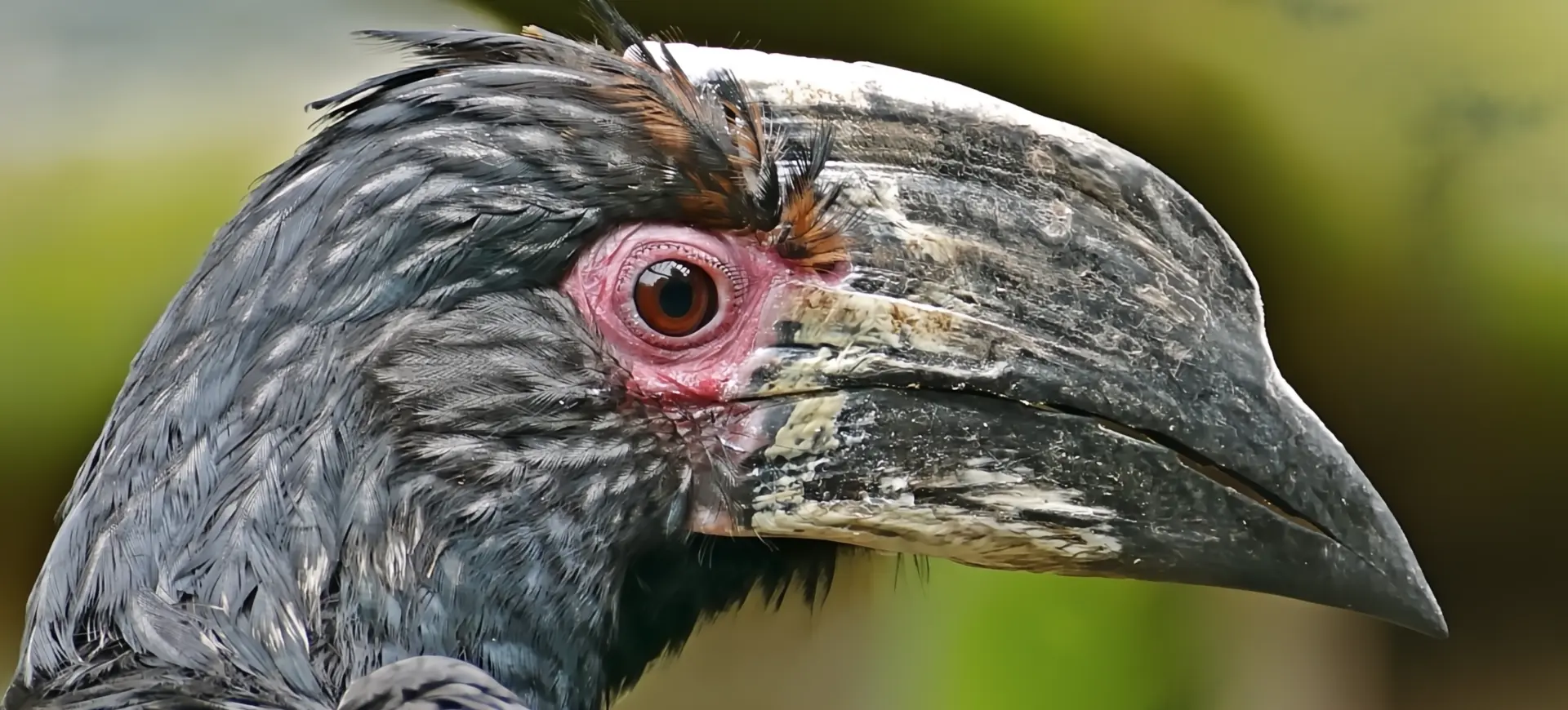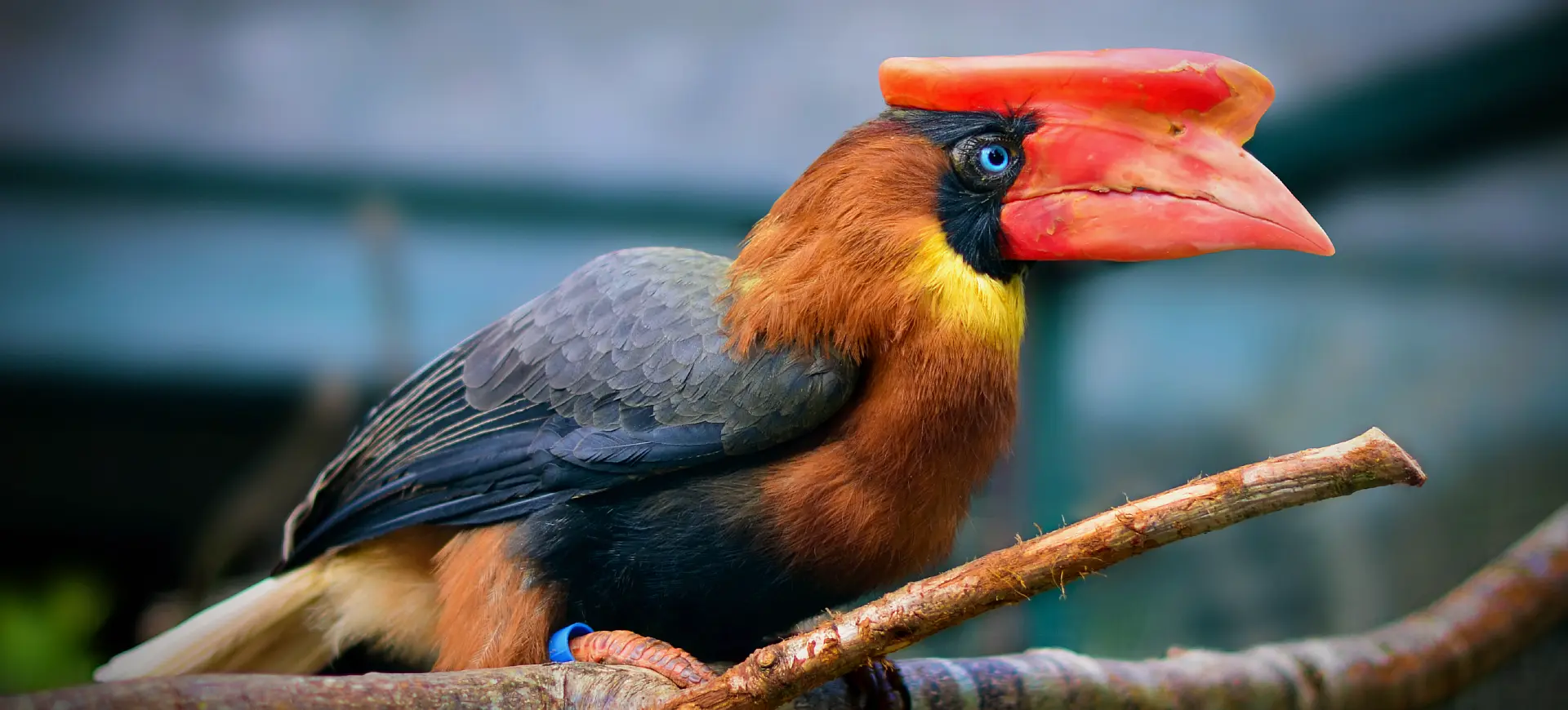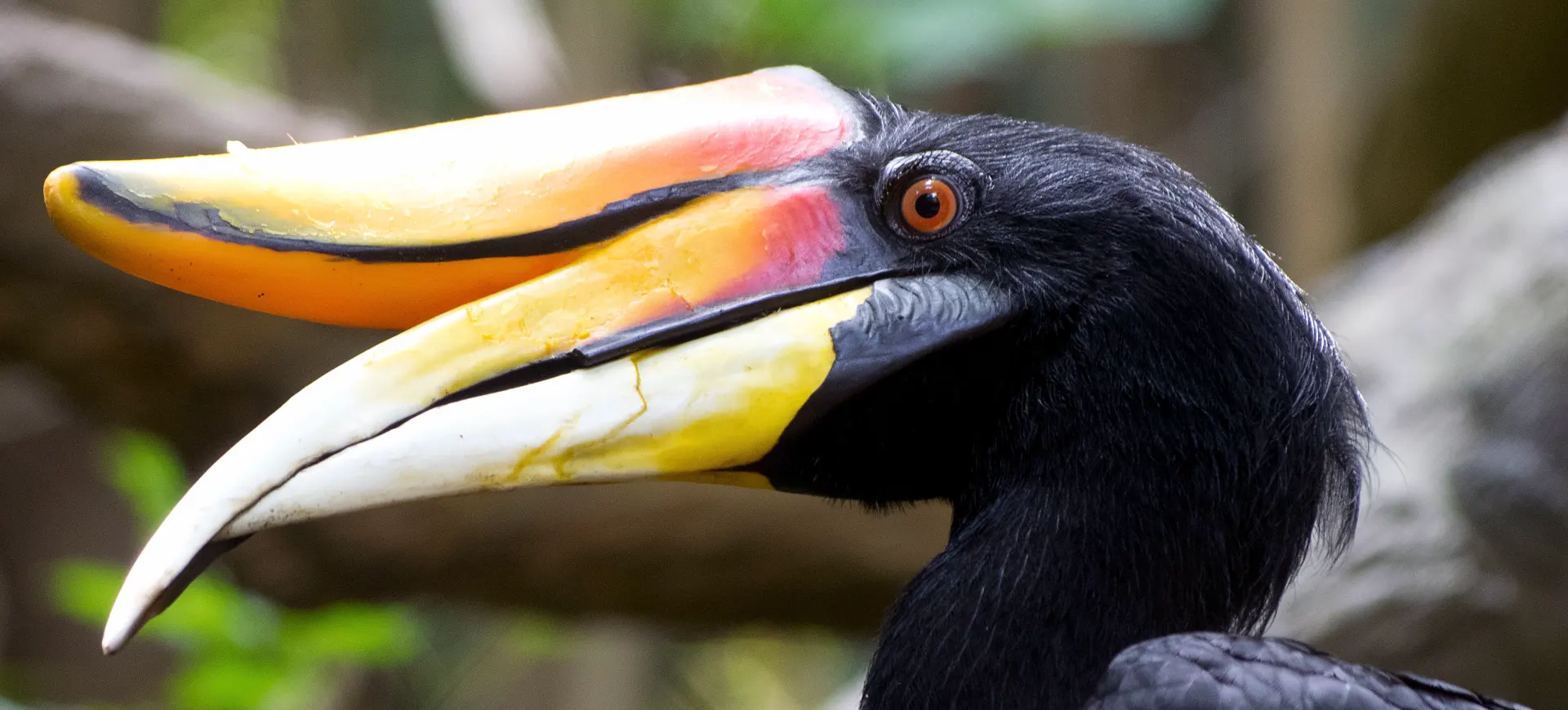Overview
The Great Hornbill (Buceros bicornis), one of the largest members of the hornbill family, is renowned for its impressive size and vibrant bill with a prominent casque on top. Found in the dense forests of the Indian subcontinent and Southeast Asia, this species plays a crucial role in its ecosystem as a seed disperser, aiding in the growth of forest trees. Great Hornbills are easily recognizable by their black and white plumage and the bright yellow and black coloration of their bills. They are monogamous birds, often forming lifelong bonds with their partners, and are known for their loud, echoing calls that can be heard kilometers away.
Great Hornbills have a distinctive nesting behavior, where females seal themselves in tree cavities with mud and droppings, leaving only a small slit through which the male feeds them and their offspring. This remarkable behavior protects the eggs and the young from potential predators. These birds are vital for maintaining the health of their forest habitats, as they help in dispersing seeds from the fruits they consume. However, Great Hornbills face habitat destruction and hunting threats, making conservation efforts essential for their survival.
Their diet consists primarily of fruit, particularly figs, which constitute a major part of their food intake, along with small mammals, birds, reptiles, and insects. The Great Hornbill’s feeding habits not only influence the distribution and abundance of forest trees but also control the populations of certain animal species. They can consume large quantities of food, which is crucial during the breeding season to nourish the female and the chicks. Conservation initiatives aim to protect the natural habitats of Great Hornbills and ensure the availability of their food sources, supporting the ecological balance of their environments.
Taxonomy
Kingdom
Phylum
Class
Order
Family
Genus
Species
Type
Physical Description:
The Great Hornbill is a large bird, with adults reaching lengths of up to 130 cm (51 inches) from beak to tail and wingspans of up to 180 cm (71 inches), making them one of the most imposing birds in their natural habitat. Their striking bill and casque are visually distinctive and serve practical purposes, such as being used in combat and foraging for food. The male’s casque is larger and more brightly colored than the female’s, a characteristic related to mate selection. Their plumage is primarily black and white, with a yellow neck and a black band across the tail, providing camouflage among the forest canopies.
Despite their size, Great Hornbills are agile fliers capable of easily maneuvering through dense forests. The casque on the bill is hollow, which helps reduce the bill’s weight, making it easier for the bird to carry. Juveniles lack the vibrant colors of adults and develop the full coloration and casque size only as they mature. The physical adaptations of Great Hornbills, including their large size and distinctive bill, highlight their evolution to thrive in forest ecosystems.

Lifespan: Wild: ~40 years || Captivity: ~50 years

Weight: Male & Female: 4.4-8.8 lbs (2-4 kg)

Length: Male & Female: 37–51 inches (95–130 cm)

Wingspan: Male & Female: 60-70 inches (152-178 cm)
Characteristic:
Native Habitat:
Great Hornbills are found in the dense forests of the Indian subcontinent, Southeast Asia, and the Indonesian archipelago, thriving in deciduous and evergreen forests. Their habitat preferences include areas with large, mature trees that provide ample foraging opportunities and suitable nesting sites. These birds depend on extensive tracts of forest for their survival, making them vulnerable to deforestation and habitat fragmentation. The conservation of these forests is critical for maintaining Great Hornbill populations, as well as for the preservation of the overall biodiversity of these regions.
Protecting and restoring Great Hornbill habitats include establishing protected areas, sustainable forestry practices, and reforestation projects. The species’ reliance on large trees for nesting and feeding underscores the importance of conserving old-growth forests. Habitat connectivity allows Great Hornbills to move freely across their range, ensuring genetic diversity and population resilience. Through habitat conservation, Great Hornbills can continue to fulfill their ecological roles as seed dispersers and predators, contributing to the health of their forest ecosystems.
Climate Zones:
Biomes:
WWF Biomes:
Biogeographical Realms:
Continents:
Diet:
Diet & Feeding Habits:
The Great Hornbill’s diet is predominantly frugivorous, with a preference for figs and other large fruits, which they skillfully pluck using their long bills. This diet makes them key agents in seed dispersal, especially for fig trees, which are crucial components of their forest habitats. They also consume small animals, including insects, reptiles, and small mammals, adding to their role as predators in controlling the populations of these species. The ability to feed on various food sources demonstrates the Great Hornbill’s adaptability to various forest environments.
Their feeding behavior involves using their large bill to toss food items into the air before swallowing, a unique method that allows them to consume larger fruits and prey. During the breeding season, the male Great Hornbill plays a vital role in foraging and delivering food to the female and chicks, often covering large distances to find sufficient food. Preserving fruit-bearing trees in their habitats is essential to sustain Great Hornbill populations. Conservation efforts focus on maintaining the biodiversity of their habitats to ensure a continuous food supply throughout the year.
Mating Behavior:
Mating Description:
Great Hornbills form strong monogamous bonds, with pairs remaining together for many years. The female nests in a tree cavity, which is then sealed off with a plaster made from mud, droppings, and fruit pulp, leaving only a small slit through which the male feeds her and the chicks. This unique nesting strategy protects predators and ensures a high survival rate for the offspring. Both parents share in caring for the chicks, with the male playing a crucial role in providing food for the sealed female and their young.
The breeding season for Great Hornbills is timed with the abundance of food, ensuring that the chicks have a steady supply of nourishment. After the chicks are mature enough to leave the nest, the family stays together, with juveniles learning from their parents until they are independent. The conservation of suitable nesting trees is crucial for the reproductive success of Great Hornbills. Protecting the breeding habitats of Great Hornbills is essential for their conservation, highlighting the importance of preserving old-growth forests.
Reproduction Season:
Birth Type:
Pregnancy Duration:
Female Name:
Male Name:
Baby Name:
Social Structure Description:
Great Hornbills are social birds, often found in small groups or pairs, especially outside the breeding season. They communicate with various loud calls, which maintain group cohesion and signal the presence of food or threats. During the breeding season, pairs become more territorial, focusing on nesting and raising their young. The social interactions of Great Hornbills, including mutual preening and food sharing, strengthen pair bonds and group dynamics.
Studying Great Hornbill’s social behavior provides insights into their communication methods, reproductive strategies, and group living advantages. Conservation efforts that preserve their social structures are important for their overall well-being. Protecting the environments that support the complex social life of Great Hornbills is crucial for their continued survival. By understanding and conserving the social behaviors of Great Hornbills, conservationists can develop more effective strategies for protecting these majestic birds and their habitats.
Groups:
Conservation Status:
Population Trend:
Great Hornbills face a precarious future in parts of their range due to ongoing habitat destruction, illegal hunting, and the pet trade. Conservation efforts are focused on protecting their forest habitats, enforcing anti-poaching laws, and raising public awareness about the species’ plight. Great Hornbill populations have shown signs of stability in areas where conservation measures have been effectively implemented. Ongoing research and population monitoring are crucial for understanding their ecological needs and adapting conservation strategies accordingly.
The presence of Great Hornbills is a sign of healthy forest ecosystems, making their conservation a priority for environmentalists and governments alike. Restoring degraded habitats and creating protected areas is key to ensuring their survival. The Great Hornbill’s status as a flagship species means that protecting them has a positive ripple effect on the conservation of numerous other species and the overall biodiversity of their habitats. Through sustained conservation action, there is hope for reversing the decline of Great Hornbill populations and securing their future in the wild.
Population Threats:
The primary threats to Great Hornbills include deforestation for agriculture, logging, and infrastructure development, leading to significant habitat loss and fragmentation. Illegal hunting for their casques and feathers and capture for the pet trade also pose significant risks to their populations. The degradation of their habitats impacts their ability to find food and nesting sites, crucial for their survival and reproductive success. Climate change adds another layer of threat, potentially altering their forest habitats and affecting food availability.
Conservation strategies aim to mitigate these threats through legal protections, habitat conservation, and sustainable land management practices. Raising awareness about the importance of Great Hornbills and their threats is crucial for generating support for conservation initiatives. Efforts to rehabilitate and release injured or confiscated hornbills back into the wild contribute to population recovery. Protecting the natural habitats of Great Hornbills is essential for their survival and the preservation of tropical biodiversity.
Conservation Efforts:
Conservation initiatives for the Great Hornbill include establishing and expanding protected forest areas, promoting sustainable forestry practices, and enforcing laws against hunting and wildlife trade. Environmental education and community engagement programs aim to foster a conservation ethic among local populations and encourage the protection of hornbills and their habitats. Research and monitoring efforts provide valuable data on Great Hornbill ecology, distribution, and conservation status, informing effective management strategies and conservation actions. Collaboration between conservation organizations, governments, and local communities is key to successfully conserving Great Hornbill habitats.
The protection and restoration of forest ecosystems benefit not only Great Hornbills but also a wide array of biodiversity, highlighting the ecological importance of these birds. Efforts to create wildlife corridors improve habitat connectivity, facilitating the movement of hornbills and other wildlife across their range. The involvement of local communities in conservation and sustainable development projects ensures the long-term protection of Great Hornbills and their habitats. Through dedicated conservation action, there is hope for preserving the Great Hornbill and the rich biodiversity of the tropical forests they inhabit.
Additional Resources:
Fun Facts
- Great Hornbills can live for up to 50 years in captivity, highlighting their potential for longevity.
- Their casque acts as a resonating chamber, amplifying their calls throughout the forest.
- Great Hornbills fly up to 50 km (31 miles) daily for food.
- They play a vital role in their ecosystem as seed dispersers, particularly for fig trees.
- The vibrant colors of the Great Hornbill’s bill and casque are thought to play a role in mate attraction.
- They have a unique way of drinking by scooping up water with their bill and then tossing their head back.
- Great Hornbills are one of the few bird species that use mud to seal their nest cavities.
- Their eyelashes are modified feathers, which protect their eyes from debris.
- In some cultures, the Great Hornbills symbolize good luck and prosperity.
- Conservation efforts for Great Hornbills help protect countless other species that share their forest habitat, highlighting their role as an umbrella species.





